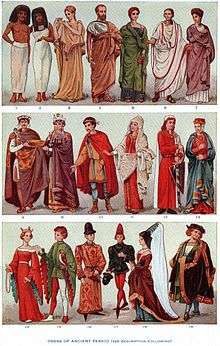Capotain
A capotain, capatain or copotain is a tall-crowned, narrow-brimmed, slightly conical "sugarloaf" hat, usually black, worn by men and women from the 1590s into the mid-seventeenth century in England and northwestern Europe. Earlier capotains had rounded crowns; later, the crown was flat at the top.
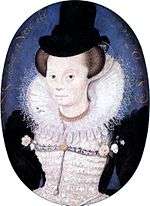
The capotain is especially associated with Puritan costume in England in the years leading up to the English Civil War and during the years of the Commonwealth. It is also commonly called a Flat Topped Hat and a Pilgrim hat, the latter for its association with the Pilgrims who settled Plymouth Colony in the 1620s. Contrary to popular myth, capotains never included buckles on the front of them;[1] this image was created in the 19th century.[2]
It has been theorised that the capotain inspired the top hat.
 England, 1592
England, 1592
(Portrait of an Unknown Lady, attributed to Robert Peake the Elder)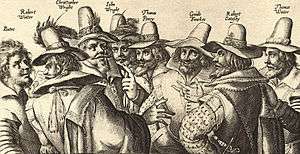 England, 1600s
England, 1600s
(Detail from a contemporary engraving of the Gunpowder Plotters)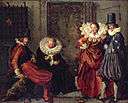 Holland, 1615 (Elegant Couples Courting by Willem Pieterszoon Buytewech)
Holland, 1615 (Elegant Couples Courting by Willem Pieterszoon Buytewech) Flanders, 1630s
Flanders, 1630s
(Man with a Hat painting by Adriaen Brouwer)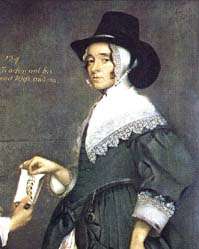 England, 1640s,
England, 1640s,
Ester Tradescant and Son (attributed to Thomas de Critz)
See also
- 1550–1600 in fashion
- 1600–1650 in fashion
- 1650–1700 in fashion
- List of headgear
- Toque
- Pilgrim's hat
References
- 17th century hats Archived October 16, 2006, at the Wayback Machine
- Brooks, Rebecca Beatrice (22 July 2018). "What Did the Pilgrims Wear?". History of Massachusetts Blog. Rebecca Beatrice Brooks. Retrieved 10 November 2019.
Further reading
- Ashelford, Jane: The Art of Dress: Clothing and Society 1500–1914, Abrams, 1996. ISBN 0-8109-6317-5 .
- Arnold, Janet: Patterns of Fashion: the cut and construction of clothes for men and women 1560–1620, Macmillan 1985. Revised edition 1986. ISBN 0-89676-083-9.
- Black, J. Anderson and Madge Garland: A History of Fashion, Morrow, 1975. ISBN 0-688-02893-4.
External links

